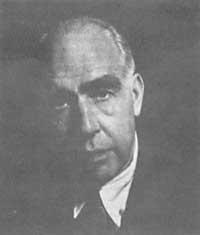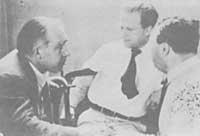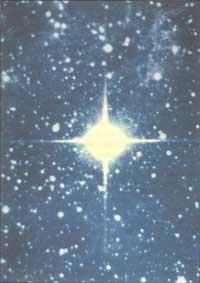Niels Bohr: stability of matter
1985/12/01 Ugalde, Jesus Iturria: Elhuyar aldizkaria

Most general chemistry courses begin with the Bohr atomic model, it is said that it does not emit energy when the electron is in a stationary orbital to explain the stability of the hydrogen atom. Then recognizing that this is Bohr's coolest idea. Of course, poor students were left unaware of where that genius is. When, over the years, the theory of electronic structure deepens further, Neils Bohr's fingers of influence are seen anywhere.
Neils Henri was born in Copenhagen on 7 October 1885, David Bohr, professor of physiology in Copenhagen, where he studied physics. He obtained his doctorate in 1911 and the same year he obtained a scholarship from the Carlsberg Foundation* to go to work with Rutherford to Cambridge. In 1916 he returned to the University of Copenhagen to teach physics.
In the atomic model of Bohr electrons are represented in stable orbits; if the atom were a small planetary system, the nucleus would be the sun and electrons the planets. Neils Bohr carried out this model in 1913, and by that time other physicists considered it a very heterodox model. Some prestigious physicists, like Otto Stern, promised to abandon physics if that nonsense was proven. When the Bohr model represented the frequencies of the hydrogen spectral lines, no one abandoned physics, they began to work with more rage.
The stability of matter was what Bohr wanted to resolve, that is, to show again and again the same aspect of matter. That is, they always form the same crystalline networks, which always produce the same chemical reactions, and a long etcetera. Perhaps we have not realized this beauty of matter for a long time, had it not been for the results that gave some important experiences at the beginning of this century. Planck discovered that the energy of an atomic system changes discontinuously, there are constant stops of energy from the radiant processes of a system (which Bohr later called stable states).
Rutherford's later experiences were of great importance in the further development of this problem that Niels Bohr discovered for years in the Rutherford laboratory. Below this deployment, Bohr posed a question that could not be left pending any longer: What are the reasons that relate them? Bohr's theory wanted to find that link.
Bohr himself knew that this atomic model was very common, that it was only a sketch of the atom, not an exact representation. But I knew how difficult it would be to become a better model. This advance came when De Broglie showed that the description of the electron could be double. Schrodinger then extended the wave mechanics.
In this theory the electron does not rotate through the nucleus, it is considered a stable wave that surrounds the nucleus. Therefore, the electron does not accelerate and therefore does not have to emit energy, like all kinds of charged particles. Now that you can understand Bohr's genetics, he knew where the stability of matter was, although he could not explain it well. To those who devoted themselves too much to formal mathematical arguments I said: no; no, you are not thinking, but logical.
Many problems arose with the evolution of these new ideas. One of them is that which Bohr designated with the principle of complementarity. Characteristics of atomic systems, such as speed and position are joined by pairs. The elements of each couple can be the subject of perfect individual occlusion but not both. This is the principle of insecurity. Werner Heisenberg thought that with Bohr the initiation could be extended to other areas at the University of Copenhagen. Thus, for Bohr reality is a canvas painted on both sides and when we look at the beauty on one side we see everything in reverse.
Bohr proposed that the same relationship between speed and position could be that existing between matter and life, body and soul, justice and patience. This proposition was well received by contemporary biologists, so that the interpretation of living systems can be done on the one hand according to the chemical and physical laws governing cellular components, and on the other according to the laws of life, which govern the entire cell and organism. Therefore, physical or chemical investigation of the life of certain elements would not be possible.
Also noteworthy is Bohr's contribution to the theory of the atomic nucleus. During his years in the United States, Niels Bohr sought a theory to explain the mechanism of atomic fission. He compared the nucleus to the liquid droplet gate and was able to explain many particularities of nuclear fission. In addition, Bohr predicted that a uranium isotope, 235 U (discovered two years earlier by Dempster) was physicized.
Niels Bohr profoundly defended quantum theory. Under his leadership, he converted many aspects of this new theory. Einstein repeatedly responded to the arguments set forth against the integrity of quantum theory, and even though this debate is currently open (see I. Belifante, Int. J. Quantum Chem. 17, 1 (1980), J. L. Sanchez-Gómez, J.M. Sanchez-Ron, An. Fis. 79, 85 (1983) can be the perfect witness to Bohr's great work.

Niels Bohr was in Denmark when Hitler's armies entered in 1940. And three years later he was forced to flee because he did not want to cooperate with the German army. He fled to England and from there to the United States to work on the Los Alamos atomic bomb project. He dissolves in an acid the Nobel gold medal he received in 1922 before being handed over to Denmark to rescue the medal that precipitated gold when he returned to Denmark.
This was the symbol of the hook of an illness, but he soon realized that he was facing another evil, perhaps worse: the atomic war. Bohr opted for non-military uses of atomic energy and in 1955 organized the first conference entitled Geneva the atoms of peace. Niels Bohr died in Copenhagen on 18 November 1962.

Gai honi buruzko eduki gehiago
Elhuyarrek garatutako teknologia




